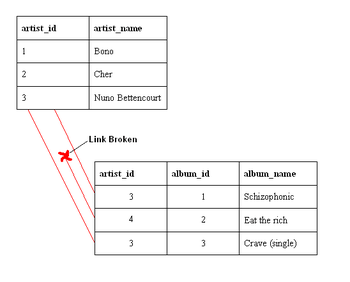Referential integrity

artist_id) value in the album table that references a non-existent artist — in other words there is a foreign key value with no corresponding primary key value in the referenced table. What happened here was that there was an artist called "Aerosmith", with an artist_id of 4, which was deleted from the artist table. However, the album "Eat the Rich" referred to this artist. With referential integrity enforced, this would not have been possible.Referential integrity is a property of data which, when satisfied, requires every value of one attribute (column) of a relation (table) to exist as a value of another attribute (column) in a different (or the same) relation (table).[1]
For referential integrity to hold in a relational database, any field in a table that is declared a foreign key can contain either a null value, or only values from a parent table's primary key or a candidate key.[2] In other words, when a foreign key value is used it must reference a valid, existing primary key in the parent table. For instance, deleting a record that contains a value referred to by a foreign key in another table would break referential integrity. Some relational database management systems (RDBMS) can enforce referential integrity, normally either by deleting the foreign key rows as well to maintain integrity, or by returning an error and not performing the delete. Which method is used may be determined by a referential integrity constraint defined in a data dictionary.
The adjective 'referential' describes the action that a foreign key performs, 'referring' to a link field in another table. In simple terms, 'referential integrity' is a guarantee that the target it 'refers' to will be found. A lack of referential integrity in a database can lead relational databases to return incomplete data, usually with no indication of an error.
Formalization
An inclusion dependency over two (possibly identical) predicates and from a schema is written , where the , are distinct attributes (column names) of and . It implies that the tuples of values appearing in columns for facts of must also appear as a tuple of values in columns for some fact of .
Logical implication between inclusion dependencies can be axiomatized by inference rules[3]:193 and can be decided by a PSPACE algorithm. The problem can be shown to be PSPACE-complete by reduction from the acceptance problem for a linear bounded automaton.[3]:196 However, logical implication between dependencies that can be inclusion dependencies or functional dependencies is undecidable by reduction from the word problem for monoids.[3]:199
See also
- Dangling pointer
- Declarative Referential Integrity
- Domain/key normal form
- Entity integrity
- Functional dependency
- Propagation constraint
- Surrogate key
- Slowly changing dimension
References
- ↑ Mike Chapple. "Referential Integrity". http://databases.about.com/: About.com. Retrieved 2011-03-20.
Definition: Referential integrity is a database concept that ensures that relationships between tables remain consistent. When one table has a foreign key to another table, the concept of referential integrity states that you may not add a record to the table that contains the foreign key unless there is a corresponding record in the linked table.
- ↑ Coronel et al. (2013). Database Systems 10th ed. Cengage Learning, ISBN 978-1-111-96960-8
- 1 2 3 Serge Abiteboul, Richard B. Hull, Victor Vianu (1994). "9. Inclusion Dependency". Foundations of Databases. Addison-Wesley. pp. 192–199.